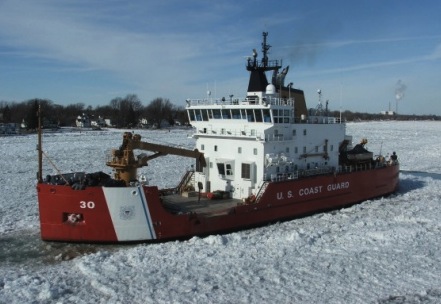The following is the text of a news release from the U.S. Coast Guard:
(CLEVELAND) — U.S. and Canadian Coast Guard crews concluded the nation’s largest domestic icebreaking operation Monday, after more than four months of icebreaking operations in the Great Lakes.
Coast Guard Sector Sault Ste. Marie, Mich., plans and runs Operation Taconite, an icebreaking operation facilitating the flow of commerce across Lake Superior and Lake Michigan, the northern half of Lake Huron, the St. Marys River and the Straits of Mackinac.
During the 122 days of the operation, seven U.S. Coast Guard and three Canadian Coast Guard icebreakers spent more than 3,181 hours breaking ice for convoys and assisted in 677 commercial vessel transits to move an estimated 23.7 million tons of dry bulk and liquid cargoes with an estimated value of $829 million. These crucial commodities sustain industrial production and power generation for the Great Lakes region during the winter months. Icebreakers provided direct assistance for 353 of the transits.
An additional 3,658 hours of icebreaking established and maintained tracks through the ice-choked waterways of Georgian Bay, Straits of Mackinac, Green Bay, southern Lake Michigan, St. Marys River, and across Lake Superior.
Coast Guard Sector Detroit coordinates Operation Coal Shovel, an icebreaking operation facilitating the flow of commerce across southern Lake Huron, Lake St. Clair, the St. Clair and Detroit River systems, Lake Erie and Lake Ontario. It commenced Jan. 9 and concluded April 17.
Operation Coal Shovel spanned 100 consecutive days and included 2,430 hours of U.S. icebreaking. During the season Operation Coal Shovel facilitated 153 vessel transits that moved a total 29 million tons of cargo worth over $2 billion. Coast Guard icebreakers also provided emergency flood mitigation for five communities.
U.S. and Canadian crews coordinate closely to tackle extreme ice conditions across the Great Lakes. In January, after three days of concentrated effort, U.S. and Canadian Coast Guard icebreakers concluded flushing operations and cleared two significant plugs in the St. Clair River. The combined efforts of the Coast Guard cutters Bristol Bay, Mackinaw, Neah Bay, and Canadian Coast Guard ships Griffon and Samuel Risley to break the St. Clair River, South Channel, Middle Channel and North Channel, relieved high water levels nearing the flood stage throughout the St. Clair River while re-establishing current and ice flow in the area.
In February, U.S. and Canadian Coast Guard crews worked together to break free the motor vessel Arthur M. Anderson, which was beset in ice near Conneaut Harbor, Ohio, and turned it around in Lake Erie so it could transit to Sturgeon Bay, Wis., for its winter layup.
Also in February, the Coast Guard cutter Bristol Bay, a 140-foot icebreaking tug home-ported in Detroit, spent several days battling 8 to 10 feet of ice in areas and brash ice up to 5 to 6 feet thick outside of Ashtabula, Ohio. The Canadian Coast Guard ship Griffon assisted.
"The U.S. and Canada have a strong icebreaking partnership," said Rear Adm. Fred Midgette, commander, Coast Guard 9th District. “Our goal is to get the commercial traffic moving and keep it moving. I was extremely impressed with the coordinated team effort with our Canadian partners and everyone performed with distinction.”

